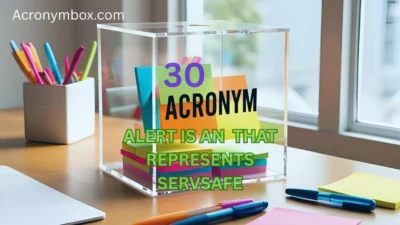In today’s fast-moving world of information, acronyms are everywhere. One such term that pops up often in workplace emails, government communications, or military lingo is FYSA. So, what exactly does “FYSA acronym” mean?
It stands for “For Your Situational Awareness.”
But FYSA isn’t just another abbreviation—it’s a subtle cue that says: “Heads up. You might want to know this, even if you don’t need to act on it right away.” It’s informative, not directive. It’s professional, not panicky.
In this article, we’ll explore 30 alternatives to the FYSA acronym. We’ll break down when to use each one, how their tone differs, and offer examples to help you choose the right expression—whether you’re writing an email, reporting data, or casually updating a colleague.
What Does FYSA Really Mean?
At its core, FYSA is a neutral, professional heads-up. It’s most commonly used in:
- Emails: “FYSA, the new server patch will go live Friday.”
- Reports: “FYSA: Security protocols have been revised.”
- Meetings: “Just FYSA, marketing has pushed the campaign date.”
It doesn’t ask for input. It simply flags something important enough to know, even if you don’t have to react.
The tone of FYSA is:
- Informative
- Calm
- Proactive
- Low-pressure
- Context-focused
Now, let’s look at 30 acronym-style or stylistic alternatives you can use in different professional or casual settings—each with subtle differences in tone or urgency.
Alternatives to FYSA Acronym (With Examples & Usage Tips)
1. Heads-Up
A friendly, informal version of FYSA.
Use in casual team settings.
“Heads-up: The meeting time moved to 3 PM.”
2. Note That
Neutral, suitable for emails or briefings.
Use in formal updates.
“Note that the contract has been revised.”
3. Just So You Know (JSYK)
Slightly informal, gentle tone.
Use when softening sensitive news.
“Just so you know, the deadline might change.”
4. Be Aware
Direct, slightly more formal than FYSA.
Use in situations needing quiet attention.
“Be aware: We’ve had login delays reported.”
5. Keep in Mind
Suggests mental preparation.
Use when planning.
“Keep in mind: The system will be offline Friday.”
6. For Your Reference (FYR)
Often used with documents or attachments.
Use in sharing source material.
“FYR, here’s the audit summary from last quarter.”
7. Take Note
Slightly authoritative.
Use in instructional or training content.
“Take note of the new password rules.”
8. In Case You Need It
Caring and helpful.
Use in team support or knowledge sharing.
“In case you need it, here’s the link to last year’s report.”
9. Quick Update
Emphasizes new or changing info.
Use for recent developments.
“Quick update: The CEO will attend the call.”
10. Friendly Reminder
Used to gently recall something.
Use in ongoing projects or events.
“Friendly reminder: Invoices are due by Monday.”
11. Just Flagging
Casual and slightly more visual.
Use for surfacing important details.
“Just flagging this in case you missed it.”
12. Sharing For Visibility
Collaborative tone.
Use in cross-functional emails.
“Sharing for visibility: Legal reviewed the terms.”
13. Logging This
Useful for documentation.
Use when noting details for future reference.
“Logging this here: Draft 2 was sent today.”
14. To Make You Aware
Direct and clear.
Use in professional writing.
“To make you aware, the office will close early.”
15. In Case It Comes Up
Anticipates possible relevance.
Use in supportive communication.
“In case it comes up, HR has changed the process.”
16. Point of Info
Used in meetings or minutes.
Use when adding non-critical facts.
“Point of info: Q2 projections are slightly down.”
17. Just a Ping
Very casual, team-friendly.
Use for Slack or internal chat updates.
“Just a ping—finance finalized the budget.”
18. Take a Look At
Action-oriented, soft.
Use when recommending awareness.
“Take a look at the revised strategy deck.”
19. FYI (For Your Information)
Classic cousin to FYSA. Slightly more general.
Use in almost any setting.
“FYI: Marketing needs feedback by Friday.”
20. No Action Needed
Clarifies expectations clearly.
Use to reduce pressure.
“No action needed—just wanted to keep you posted.”
21. Awareness Only
Clear intent to inform, not engage.
Use in compliance or regulatory contexts.
“Awareness only: New tax rule impacts U.S. contracts.”
22. Worth Knowing
Highlights relevance.
Use in strategy or leadership updates.
“Worth knowing: A new competitor entered the market.”
23. Flagging for Context
Shows info as part of a bigger picture.
Use when explaining interconnected events.
“Flagging for context: This ties to last week’s outage.”
24. Situational Update
Formal, useful in reporting.
Use for operational summaries.
“Situational update: All teams are operating remotely.”
25. Marking This
Subtly signals future importance.
Use in fast-paced threads.
“Marking this for awareness: IT will restart servers.”
26. Circling In
Used to bring people into awareness.
Use in group emails or chains.
“Circling you in for visibility.”
27. Heads-Up Alert
Slightly more urgent than “heads-up.”
Use for emerging risks.
“Heads-up alert: Outage window may shift earlier.”
28. Just Noting
Very light, minimal tone.
Use for low-impact mentions.
“Just noting: I’ll be OOO Friday.”
29. Gentle Nudge
Soft and socially smooth.
Use for lightly urgent reminders.
“Gentle nudge to review the proposal today.”
30. Proactive Share
Communicates initiative.
Use in leadership, support, or mentorship.
“Proactive share: This resource helped me understand the changes.”
How to Choose the Right FYSA Alternative
Here’s how to pick the perfect phrase depending on tone and context:
| Emotion/Tone | Best Alternatives |
| Friendly/Informal | Heads-up, Just so you know, Just pinging |
| Formal/Neutral | Note that, FYR, Be aware |
| Gentle/Polite | Friendly reminder, Gentle nudge, In case |
| Directive/Clear | Take note, Marking this, Awareness only |
| Teamwork/Visibility | Sharing for visibility, Circling in, Proactive share |
| Reducing Pressure | No action needed, FYI, Just noting |
Also, consider cultural context—some regions prefer more direct phrasing (e.g., “Be aware”), while others favor softer expressions (e.g., “FYI” or “just so you know”).
Conclusion
FYSA is a small but mighty phrase in professional communication. Whether you’re managing a team, sharing updates, or keeping things transparent, how you deliver context matters.
Use this list to adjust tone, show respect, and stay clear—without overwhelming your audience.
Remember: You don’t always need to take action. Sometimes, being informed is action enough.




